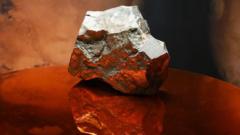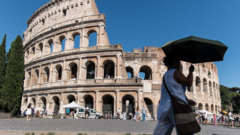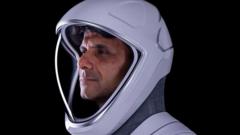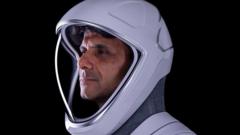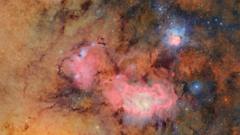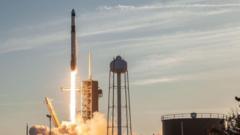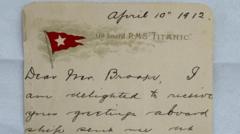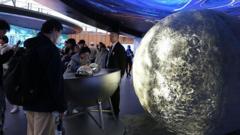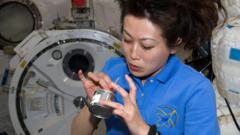NASA's Parker Solar Probe has made history, surviving the closest approach to the Sun ever recorded, brushing just 3.8 million miles from its surface while gathering crucial scientific data.
Historic Milestone: NASA's Parker Solar Probe Achieves Closest Passage to the Sun

Historic Milestone: NASA's Parker Solar Probe Achieves Closest Passage to the Sun
NASA's groundbreaking spacecraft endures extreme conditions to探索 the Sun's mysteries.
The NASA Parker Solar Probe has accomplished a remarkable feat by surviving the closest flyby of the Sun ever, breaking previous records in its mission to explore our star. The spacecraft successfully communicated with mission control just before midnight on Thursday after several days of silence during its high-temperature approach. According to NASA, the probe emerged "safe" and continues to operate normally post-encounter. During its descent into the Sun's outer atmosphere on Christmas Eve, the probe withstood temperatures soaring to 1,800°F (980°C) and radiation intense enough to potentially damage its electronics.
The Parker Solar Probe’s results are pivotal; it allows scientists to conduct measurements that will shed light on how solar materials are heated to millions of degrees, trace the origins of the solar wind, and discover how high-energy particles reach near light speed. Dr. Nicola Fox, NASA's head of science, articulated the significance of this mission saying, "To truly understand the Sun, you must experience its atmosphere first-hand."
The spacecraft, launched in 2018 with the aim of venturing towards the center of our solar system, had already made 21 close encounters with the Sun before setting its record-breaking Christmas Eve mark. During this latest pass, the probe descended to an unprecedented distance of 3.8 million miles (6.1 million km) from the solar surface. To put this in perspective, if one were to place the Sun and Earth one meter apart, the Parker Solar Probe would only be 4 cm away from the Sun.
Despite the fact that this distance may seem substantial, Dr. Fox underscored its significance. The probe managed to endure temperatures of 1,400°C and extreme radiation shielded by a carbon-composite barrier measuring 11.5 cm (4.5 in) thick. The success of the mission relied on the swift entry and exit strategy, enabling the spacecraft to operate at a staggering speed of 430,000 mph (692,000 kph)—which is akin to flying from London to New York in just under 30 seconds.
The rationale behind this ambitious venture is to understand why the Sun's corona reaches such high temperatures, particularly since it sits further from the star than its surface, which is around 6,000°C. Scientists speculate that by analyzing data collected during the close pass, they may unlock long-standing questions about this phenomenon. The mission is likewise expected to augment our understanding of solar wind—this continuous outpouring of charged particles that, when interacting with Earth's magnetic field, create breathtaking auroras but can also contribute to disruptions in electronics and power grids.
Facing an anxious wait over the holiday season, NASA scientists eagerly awaited contact with the probe. Dr. Fox experienced a mix of excitement and nerves, anticipating a simple message—a green heart—to confirm the spacecraft's safety upon its return signals. Although she confessed to worrying about the probe throughout this challenging endeavor, Dr. Fox expressed unwavering faith in the probe's robust design built to weather such extreme conditions.
The Parker Solar Probe’s results are pivotal; it allows scientists to conduct measurements that will shed light on how solar materials are heated to millions of degrees, trace the origins of the solar wind, and discover how high-energy particles reach near light speed. Dr. Nicola Fox, NASA's head of science, articulated the significance of this mission saying, "To truly understand the Sun, you must experience its atmosphere first-hand."
The spacecraft, launched in 2018 with the aim of venturing towards the center of our solar system, had already made 21 close encounters with the Sun before setting its record-breaking Christmas Eve mark. During this latest pass, the probe descended to an unprecedented distance of 3.8 million miles (6.1 million km) from the solar surface. To put this in perspective, if one were to place the Sun and Earth one meter apart, the Parker Solar Probe would only be 4 cm away from the Sun.
Despite the fact that this distance may seem substantial, Dr. Fox underscored its significance. The probe managed to endure temperatures of 1,400°C and extreme radiation shielded by a carbon-composite barrier measuring 11.5 cm (4.5 in) thick. The success of the mission relied on the swift entry and exit strategy, enabling the spacecraft to operate at a staggering speed of 430,000 mph (692,000 kph)—which is akin to flying from London to New York in just under 30 seconds.
The rationale behind this ambitious venture is to understand why the Sun's corona reaches such high temperatures, particularly since it sits further from the star than its surface, which is around 6,000°C. Scientists speculate that by analyzing data collected during the close pass, they may unlock long-standing questions about this phenomenon. The mission is likewise expected to augment our understanding of solar wind—this continuous outpouring of charged particles that, when interacting with Earth's magnetic field, create breathtaking auroras but can also contribute to disruptions in electronics and power grids.
Facing an anxious wait over the holiday season, NASA scientists eagerly awaited contact with the probe. Dr. Fox experienced a mix of excitement and nerves, anticipating a simple message—a green heart—to confirm the spacecraft's safety upon its return signals. Although she confessed to worrying about the probe throughout this challenging endeavor, Dr. Fox expressed unwavering faith in the probe's robust design built to weather such extreme conditions.

